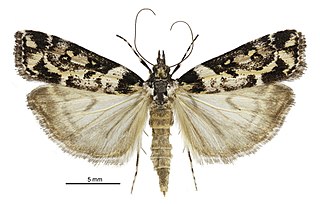Flexiptera is a monotypic moth genus in the family Gelechiidae erected by Anthonie Johannes Theodorus Janse in 1958. Its only species, Flexiptera revoluta, was first described by Edward Meyrick in 1918. It is found in South Africa.
Naera is a genus of moth in the family Gelechiidae. It contains the species Naera fuscocristatella, which is found in North America, where it has been recorded from Alabama, Kansas, Louisiana, Mississippi, Tennessee and Texas.
Phylopatris is a genus of moth in the family Gelechiidae. It contains the single species Phylopatris terpnodes, which is found in Brazil (Amazonas) and Peru.

Eudonia diphtheralis is a species of moth in the family Crambidae. It is endemic to New Zealand.
Helcystogramma septella is a moth in the family Gelechiidae. It was described by Philipp Christoph Zeller in 1852. It is found in Malawi, South Africa, Tanzania and the Gambia.
Hypatima dissidens is a species of moth in the family Gelechiidae. It was described by Edward Meyrick in 1913. It is found in Mpumalanga, South Africa.
Gelechia sematica is a moth of the family Gelechiidae first described by Edward Meyrick in 1913. It is found in Namibia and South Africa.
Ephysteris suasoria is a moth in the family Gelechiidae. It was described by Edward Meyrick in 1918. It is found in southern India and Palestine.
Pyncostola pachyacma is a moth of the family Gelechiidae. It was described by Edward Meyrick in 1926. It is found in South Africa, where it has been recorded from the Western Cape.
Photodotis prochalina is a moth of the family Gelechiidae. It was described by Edward Meyrick in 1911. It is found in South Africa.
Orphnolechia acridula is a moth of the family Depressariidae first described by Edward Meyrick in 1918. It is found in French Guiana.
Lecithocera excaecata is a moth in the family Lecithoceridae. It was described by Edward Meyrick in 1922. It is found on Java in Indonesia.
Zauclophora pelodes is a moth in the family Xyloryctidae. It was described by Alfred Jefferis Turner in 1900. It is found in Australia, where it has been recorded from New South Wales and Queensland.
Pseudocentris is a monotypic moth genus in the family Depressariidae. Its only species, Pseudocentris testudinea, is found in Peru. Both the genus and species were first described by Edward Meyrick in 1921.
Aeolanthes deltogramma is a moth in the family Depressariidae. It was described by Edward Meyrick in 1923. It is found in India (Assam).
Psittacastis trierica is a moth in the family Depressariidae. It was described by Edward Meyrick in 1909. It is found in Bolivia.
Psittacastis stigmaphylli is a moth in the family Depressariidae. It was described by Lord Walsingham in 1912. It is found on Jamaica.
Hypercallia argyropa is a moth in the family Depressariidae. It was described by Edward Meyrick in 1914. It is found in Peru.
Antaeotricha encyclia is a species of moth in the family Depressariidae. It was described by Edward Meyrick in 1915. It is found in Colombia.
Chlamydastis crateroptila is a moth in the family Depressariidae. It was described by Edward Meyrick in 1918. It is found in French Guiana.
